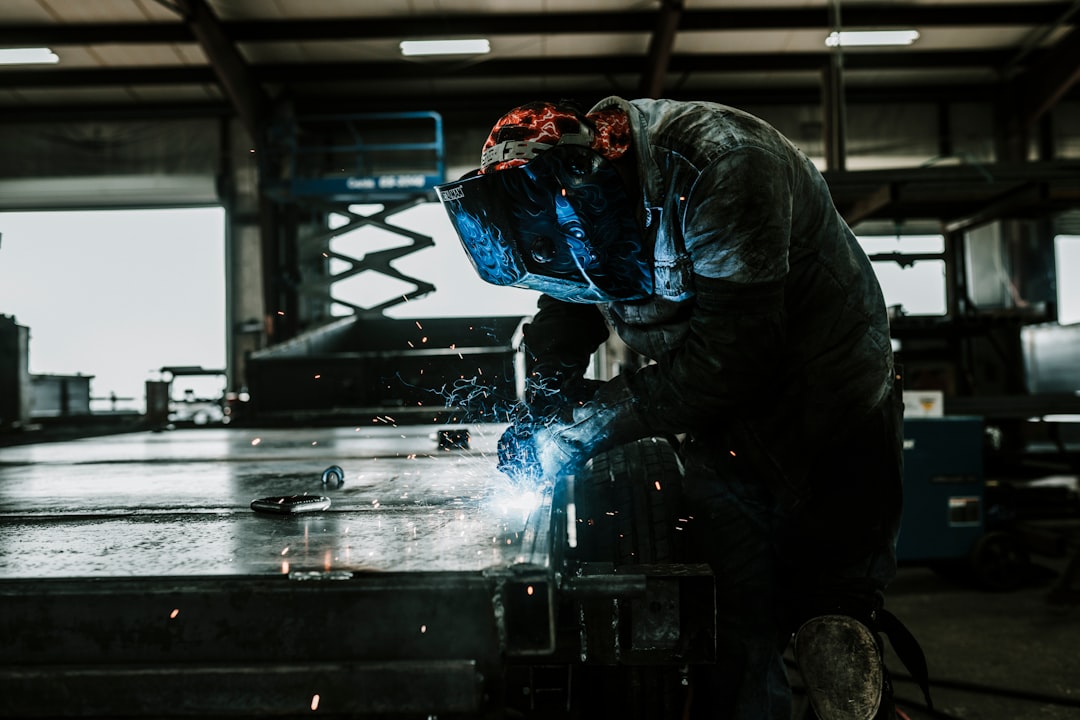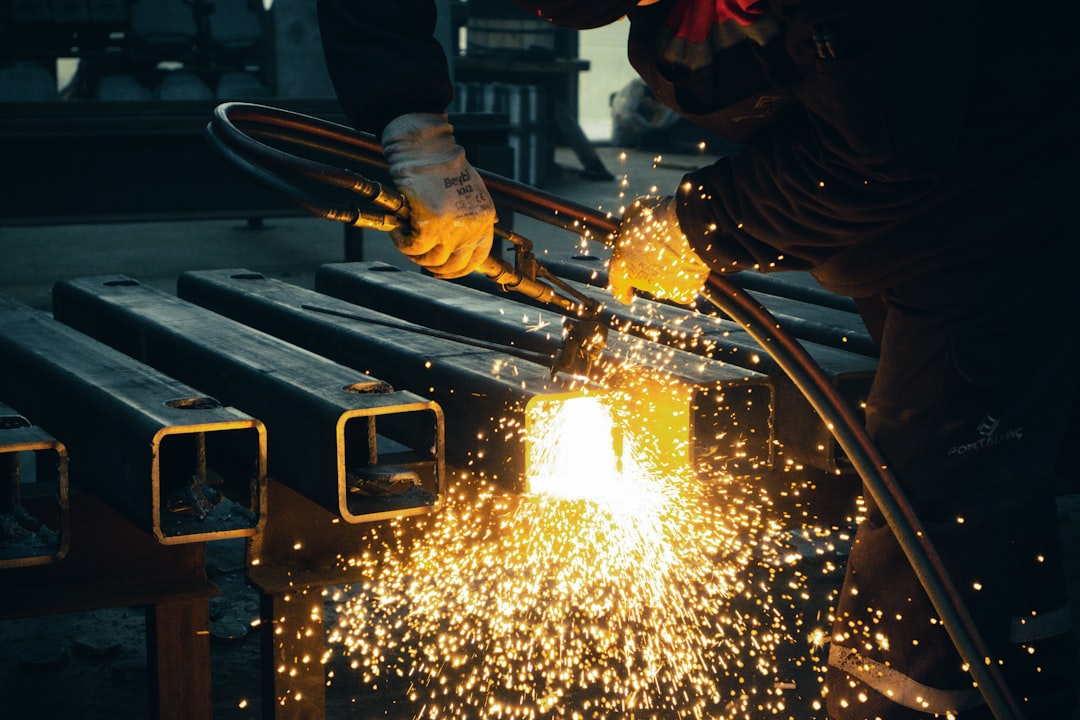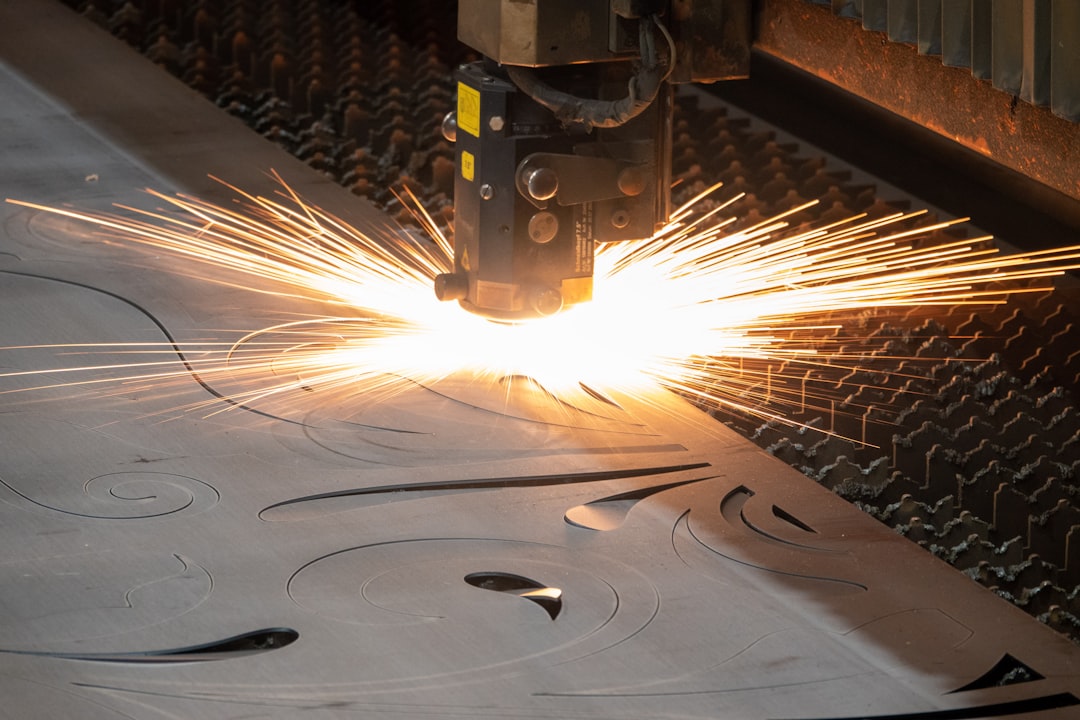

Engage prospects with a scan and streamline customer engagement with FREE QR code marketing tools by Sona – no strings attached!
Create a Free QR CodeFree consultation

No commitment

Engage prospects with a scan and streamline customer engagement with FREE QR code marketing tools by Sona – no strings attached!
Create a Free QR CodeFree consultation

No commitment
QR codes have evolved from a novelty to a strategic powerhouse in bridging offline engagement with online action. For steel fabrication equipment providers, an industry known for complex, high-value products and fragmented customer journeys, QR codes represent an effective way to streamline operations, offer instant access to critical information, and improve customer interactions. These advancements are crucial in a space where manual processes and paperwork often result in missed opportunities and lapses in follow-up.
As steel fabrication machinery and industrial steel equipment become more sophisticated, industry expectations increase for fast, personalized support and immediate access to documentation, training, and maintenance resources, directly from the field or shop floor. This demand, paired with the ongoing reality of missing high-value prospects who never formally register interest, makes digitizing analog touchpoints increasingly urgent for steel equipment providers aiming to compete efficiently.
QR codes connect physical assets with digital experiences, reshaping equipment onboarding, compliance tracking, and capturing buyer interest at the moment of intent. By deploying QR codes strategically, steel fabrication equipment providers can transform analog friction points into seamless digital journeys, improve lead quality by identifying hidden prospects, and deliver measurable impact throughout the buyer journey.
For steel fabrication equipment providers, outdated analog workflows like printed manuals, paper forms, or manual compliance logs create significant efficiency barriers. Operators misplace binders, technicians handwrite service notes that never make it to the CRM, and marketing teams lose track of event visitors who leave without swapping business cards. Valuable leads and critical engagement signals are often lost when there is no easy way to capture them at the point of interaction.
QR codes provide a straightforward bridge between these physical touchpoints and the digital resources customers expect. Providers can recover lost opportunities, such as high-fit prospects who never fill out a form, by enabling instant access to digital registration, support, or service content that logs all activity for follow-up. With the right platform, each scan becomes an event with context, pushing data into your CRM and triggering workflows for sales and service.
Here is how to implement this transformation:
Modern QR management platforms digitize workflows and aggregate data within your CRM. A solution like Sona QR centralizes code creation, dynamic destination control, and analytics, unlocking timely retargeting, ensuring valuable leads are never missed, and replacing guesswork with actionable insights. Start creating QR codes for free: Create QR codes for free.

Steel fabrication equipment providers often struggle to convert offline interest on factory floors, at dealer locations, and at trade shows into digital engagement and actionable data. A procurement director may stop by your booth for a quick product walk-through but leave before the team captures details. An operator may watch a setup video on a colleague’s phone without ever registering their device. These anonymous engagements dilute your pipeline and impair post-sale support.
Traditional offline-to-online handoffs lose leads who are not ready to fill out forms or have direct discussions. QR codes solve this by bringing the digital action right to the moment of interest. A scan can launch an instant demo scheduler, a maintenance ticket, a part reorder form, or a short qualification flow that logs to your CRM. Dynamic QR codes add flexibility by letting providers adapt resources after deployment and track precisely which channel or asset drives results.
By making the offline-to-online journey measurable, steel fabrication providers reduce wasted outreach, enable more responsive support, and turn fleeting touchpoints into meaningful signals. The result is improved conversion from first interaction to follow-up, better prioritization of sales activity, and a clearer understanding of what truly drives engagement across high-value buying committees.

Steel fabrication workflows require flexible information delivery. A single plant floor may need access to spec sheets, maintenance forms, and emergency contacts, while the sales team needs tools for contact sharing and demo scheduling. Modern QR codes handle all of these with format options tuned to specific tasks.
For steel fabrication equipment providers, prioritize web links and forms for documentation and data capture, vCards at events and showrooms, and app downloads where connected equipment is part of the value proposition. With a platform like Sona QR, you can generate any of these formats, switch destinations without reprinting, and manage versions centrally to ensure accuracy and compliance.
Many steel fabrication equipment providers underutilize offline touchpoints because there is no seamless way to connect them to the digital funnel. Trade show leads go cold without prompt follow-up, maintenance requests remain unsubmitted if operators avoid cumbersome forms, and field service techs are forced to carry stacks of paperwork.
Strategic placement transforms everyday materials into growth engines. When QR codes live on equipment panels, crate labels, installation checklists, showroom signage, and dealer price sheets, you capture intent at the moment it appears. Linking scans to relevant digital experiences such as setup instructions, lead forms, demo schedulers, or parts reorders makes each interaction measurable and actionable. Explore QR on digital signage.
Every customer touchpoint can become an opportunity for insight and action. Over time, this replaces blind spots in your data with a living map of engagement across the full equipment lifecycle.

The complexity and value of industrial equipment mean providers cannot afford to overlook friction points. QR codes give teams a toolkit for removing those blockers and capturing value that previously went unmeasured.
For many providers, these use cases deliver quick wins in weeks, not months. They also build a foundation for more advanced deployments such as parts reordering, in-app training progression, and IoT-driven service escalation.
Each QR code scan is a signal that captures intent, context, and behavior. By deploying multiple QR codes across touchpoints, you can segment your audience automatically and use that data to fuel precise retargeting and follow-up campaigns. People who scan a maintenance checklist need a different conversation than those who scan a trade show demo card. This distinction matters for both conversion and customer satisfaction. See Sona’s Playbook for intent-driven retargeting.
Think in terms of roles and lifecycle stages common to steel fabrication. Operators, maintenance managers, procurement teams, and executives each scan for different reasons. Build segments that mirror these realities and feed them into your CRM and ad platforms for tailored nurture.
With Sona QR, each QR code becomes a smart entry point into your funnel. The platform automatically enriches scans with metadata, supports audience creation, and syncs with your existing stack so your marketing and sales teams act on real behavior rather than assumptions.
QR codes are more than convenient links. They act as connectors across offline and digital campaigns, enabling real-time engagement and richer data collection across every channel. For steel fabrication equipment providers, codes help unify brand experience across print catalogs, dealer materials, show floors, and on-site service visits.
By instrumenting the assets you already use, you can measure performance, increase conversions, and provide customers with consistent, low-friction access to the next step. The same code type can serve different functions depending on context, so think creatively about pairing each placement with a meaningful action.
QR codes serve as the offline onramp to your digital marketing engine. They unlock a new layer of data collection across channels that were once difficult to measure. With a centralized platform like Sona QR, you can manage all your codes, monitor performance, and sync scan data with your CRM and ad platforms for a connected, multi-channel approach.
Launching and optimizing QR campaigns in steel fabrication involves challenges that are unique to industrial environments. Codes must remain scannable on textured metals, survive cleaning solvents, and be visible in low light. Teams also need to coach operators, dealers, and event staff on how and why to use the codes.
The following execution plan balances strategy, design, and field realities. It guides you from idea to measurable outcomes while building internal muscle for ongoing optimization.
Start with problems that create friction and leave data on the table. Trade show lead capture, on-the-spot warranty activation, and digital maintenance logs are common winners because they combine high value with straightforward user actions.
Dynamic QR codes are usually the right choice for industrial use because they provide flexibility and analytics. Static codes can work for permanent resources that never change, but most customer-facing experiences benefit from dynamic control.
Design determines scannability and adoption. Industrial contexts pose special challenges like glare, vibration, metal interference, and variable lighting. Test in the environment where codes will live.
Roll out QR codes where engagement already occurs but is not captured. Create a deployment checklist for each channel so nothing is missed.
Treat your first deployment as a learning loop. The fastest gains often come from small placement or messaging changes informed by scan data.

Without comprehensive data capture, steel fabrication equipment providers are left guessing which engagement points convert and which are ignored. Missed handoffs lead to delayed follow-up, while aggregate web visits fail to reveal account-level intent. To prove impact and optimize spend, teams need visibility from the scan through to the opportunity and beyond.
Advanced QR code platforms tie every scan to its originating channel, asset, and user context, enabling true conversion tracking from initial scan to sale or support resolution. This requires dynamic codes, tagged destinations, and CRM integration so you can measure how scans influence pipeline creation, deal velocity, and customer retention.
When analytics map scans to outcomes, QR codes move from a novelty to a performance channel. Leaders can show how a specific trade show placard generated four meetings and two POs or how post-sale QR training reduced service tickets at three plants by meaningful percentages.
Common QR pitfalls such as generic codes, unclear CTAs, or lack of account-level tracking lead to underperformance and ambiguous ROI. A few operational habits prevent these issues and build momentum across teams and channels.
Two creative examples fit this vertical well. Add a QR code to monthly service invoices that opens a prefilled reorder form for wear parts to simplify procurement. Include a QR code on a machine’s maintenance tag that toggles to an after-hours support line during evenings and weekends.

Steel fabrication equipment providers use QR codes to resolve pain points like low visibility into anonymous traffic and high demo interest that does not convert due to lack of contact capture. The following examples show practical, repeatable approaches that align with typical workflows and environments.
These ideas surface previously invisible engagement signals and make it easier for teams to act. The path from interest to action becomes shorter, which is exactly what wins in complex B2B environments.
Maximizing QR code benefits requires equal attention to technology and behavior. Misplaced codes, unclear promises, or outdated content can undermine adoption. A little forethought prevents these issues and keeps campaigns relevant.
QR codes are more than a convenience; they enable transformation in the steel fabrication equipment industry by aligning operations, assets, and engagement strategies to remove persistent barriers. When every machine, document, and display becomes a digital onramp, providers capture intent at the source and respond in context.
Strategic QR code deployment enables providers to surface hidden buying intent, connect with high-value prospects, and convert analog workflows into measurable value drivers. A robust management platform like Sona QR helps teams turn every scan into actionable insight for both marketing and customer experience, while Sona.com extends those insights into multi-touch attribution and account-level reporting. For deeper identity strategies, explore Sona’s guide to account identification.
Ultimately, QR codes deliver a scalable, data-driven approach to elevating the steel fabrication equipment lifecycle. From trade show to shop floor, they turn every interaction into a real opportunity for engagement, insight, and growth. Teams that start small, measure rigorously, and iterate quickly will see the fastest gains and create a durable competitive advantage.
QR codes have transformed the steel fabrication equipment providers industry from static product catalogs into dynamic, measurable engagement channels. Whether it’s streamlining equipment access, enhancing customer support, or enabling real-time updates on machinery usage, QR codes replace manual processes with instant, mobile-friendly actions that capture valuable data to optimize operations and client relationships. Imagine instantly connecting customers and technicians to detailed equipment specs, maintenance histories, or procurement options with a simple scan—empowering smarter decisions and faster service.
With Sona QR, you can create dynamic, trackable QR codes in seconds, update campaigns without reprinting labels or manuals, and link every scan directly to actionable insights that drive efficiency and sales. No missed opportunities, just seamless integration of offline equipment with online resources and revenue growth.
Start for free with Sona QR today and turn every scan into a smarter connection, a satisfied customer, or a closed deal in steel fabrication equipment.
QR codes bridge offline engagement with online action by streamlining operations, providing instant access to information, improving customer interactions, and capturing valuable leads at the moment of intent.
They should audit analog friction points, map outcomes to use cases, design QR codes with context and clear calls to action, integrate scan data with CRM systems, and analyze scan analytics to optimize placements and messaging.
Common use cases include warranty activation and product registration, maintenance and compliance tracking, sales enablement at trade shows and demos, parts reordering, and customer onboarding.
QR codes enable instant digital engagement at touchpoints like trade shows and equipment panels, capturing buyer intent without forcing immediate conversations and feeding data into CRM for timely follow-up and lead scoring.
Web links for documentation, forms for capturing service requests and registrations, vCards for contact sharing, SMS or email for quick inquiries, Wi-Fi access for training areas, and app downloads for connected equipment.
They use dynamic QR codes with UTM parameters integrated into CRM and analytics platforms to track scan time, location, device, and attribute conversions, enabling real-time campaign adjustments and multi-touch attribution.
Designs should ensure scannability with adequate size and contrast, use durable materials like laser-etched plates or steel tags, place codes where attention is natural, and include clear, benefit-driven calls to action.
QR codes direct buyers and operators to onboarding materials, maintenance schedules, training certifications, and allow submission of service tickets, improving support responsiveness and reducing downtime.
Providers should create unique codes for different buyer journey stages, tag audiences by role and intent, track scan context such as location and timing, and sync data with CRM and ad platforms for personalized follow-up.
Dynamic QR codes allow content and destination updates after deployment, enable detailed analytics and attribution, and support retargeting and campaign flexibility without reprinting codes.
Avoid generic codes without clear CTAs, lack of unique code assignment by asset or location, failure to track scan data at account level, and neglecting to train teams on promoting QR code usage.
QR codes unify offline and digital campaigns by linking print collateral, dealer materials, events, direct mail, and digital signage to measurable online actions and consistent customer experiences.
QR codes are inexpensive to create and deploy at scale, offering high return by converting dormant touchpoints into measurable digital actions with low upfront investment.
They use durable materials like laser-etched or steel tags, test codes under variable lighting and angles, ensure high contrast and size for easy scanning even with gloves, and regularly audit and refresh codes.
By linking physical assets with digital resources, QR codes provide accurate, up-to-date information and easy access to support and training, enhancing customer experience and operational reliability.
Use Sona QR's trackable codes to improve customer acquisition and engagement today.
Create Your FREE Trackable QR Code in SecondsJoin results-focused teams combining Sona Platform automation with advanced Google Ads strategies to scale lead generation

Connect your existing CRM

Free Account Enrichment

No setup fees
No commitment required

Free consultation

Get a custom Google Ads roadmap for your business






Launch campaigns that generate qualified leads in 30 days or less.
